Innovation and Business Sustainability Levels
VerifiedAdded on 2022/12/09
|12
|3005
|326
AI Summary
This document discusses the concept of innovation and its impact on business sustainability levels. It focuses on Ikea as a case study and explores how the company aligns its innovation strategies with corporate strategies. The document also provides recommendations for Ikea to further improve its innovation response.
Contribute Materials
Your contribution can guide someone’s learning journey. Share your
documents today.
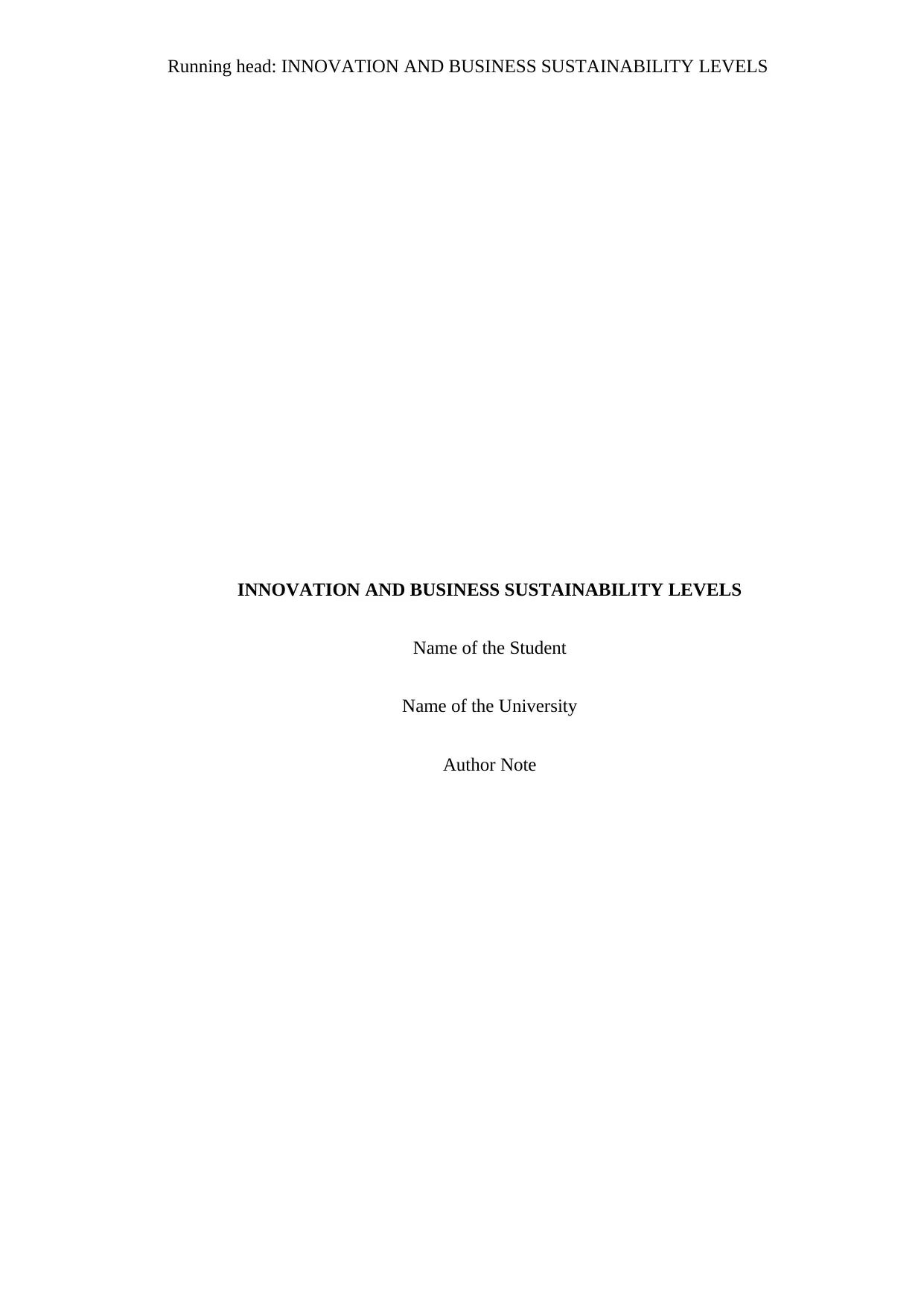
Running head: INNOVATION AND BUSINESS SUSTAINABILITY LEVELS
INNOVATION AND BUSINESS SUSTAINABILITY LEVELS
Name of the Student
Name of the University
Author Note
INNOVATION AND BUSINESS SUSTAINABILITY LEVELS
Name of the Student
Name of the University
Author Note
Secure Best Marks with AI Grader
Need help grading? Try our AI Grader for instant feedback on your assignments.
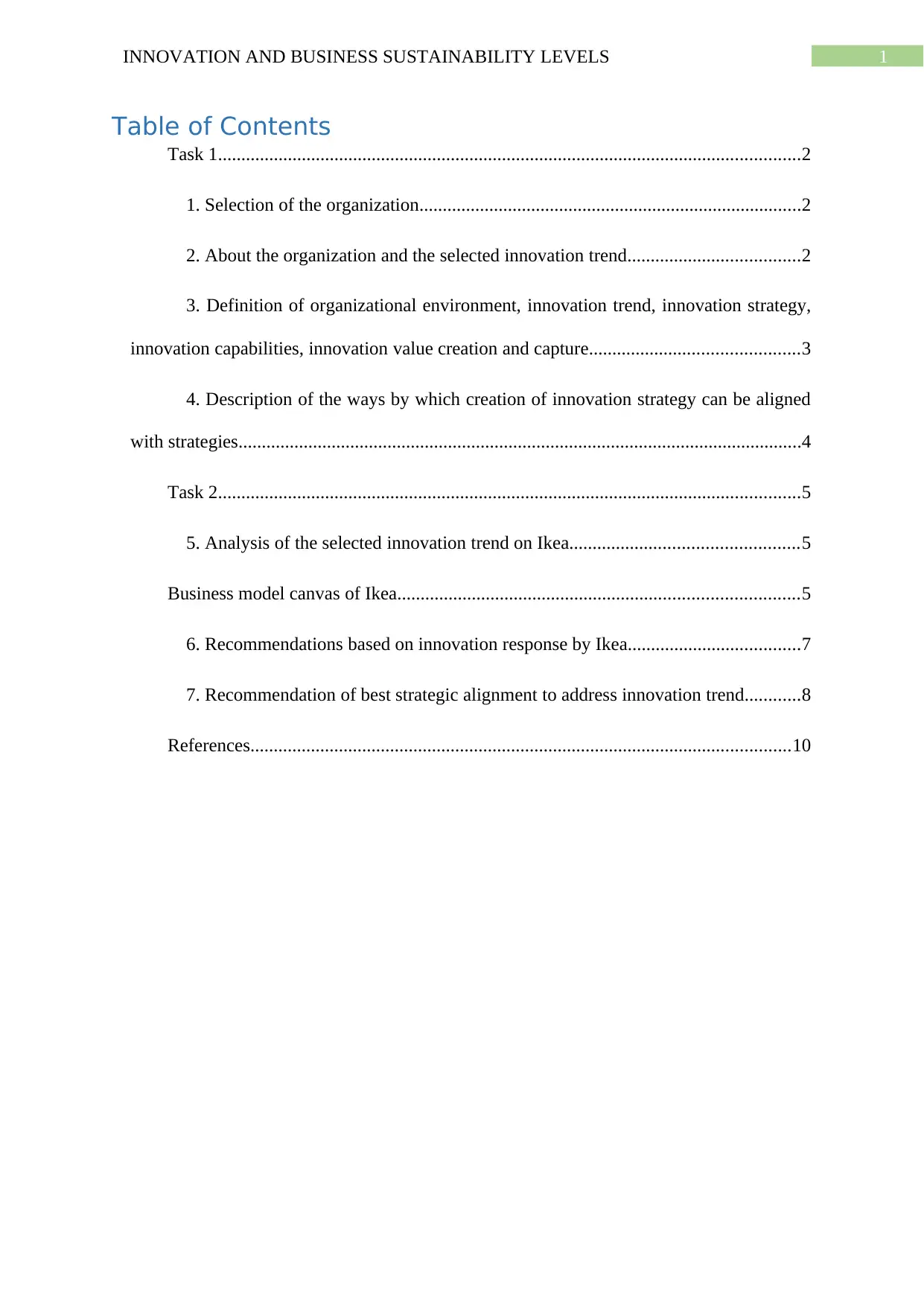
1INNOVATION AND BUSINESS SUSTAINABILITY LEVELS
Table of Contents
Task 1.............................................................................................................................2
1. Selection of the organization..................................................................................2
2. About the organization and the selected innovation trend.....................................2
3. Definition of organizational environment, innovation trend, innovation strategy,
innovation capabilities, innovation value creation and capture.............................................3
4. Description of the ways by which creation of innovation strategy can be aligned
with strategies.........................................................................................................................4
Task 2.............................................................................................................................5
5. Analysis of the selected innovation trend on Ikea.................................................5
Business model canvas of Ikea......................................................................................5
6. Recommendations based on innovation response by Ikea.....................................7
7. Recommendation of best strategic alignment to address innovation trend............8
References....................................................................................................................10
Table of Contents
Task 1.............................................................................................................................2
1. Selection of the organization..................................................................................2
2. About the organization and the selected innovation trend.....................................2
3. Definition of organizational environment, innovation trend, innovation strategy,
innovation capabilities, innovation value creation and capture.............................................3
4. Description of the ways by which creation of innovation strategy can be aligned
with strategies.........................................................................................................................4
Task 2.............................................................................................................................5
5. Analysis of the selected innovation trend on Ikea.................................................5
Business model canvas of Ikea......................................................................................5
6. Recommendations based on innovation response by Ikea.....................................7
7. Recommendation of best strategic alignment to address innovation trend............8
References....................................................................................................................10
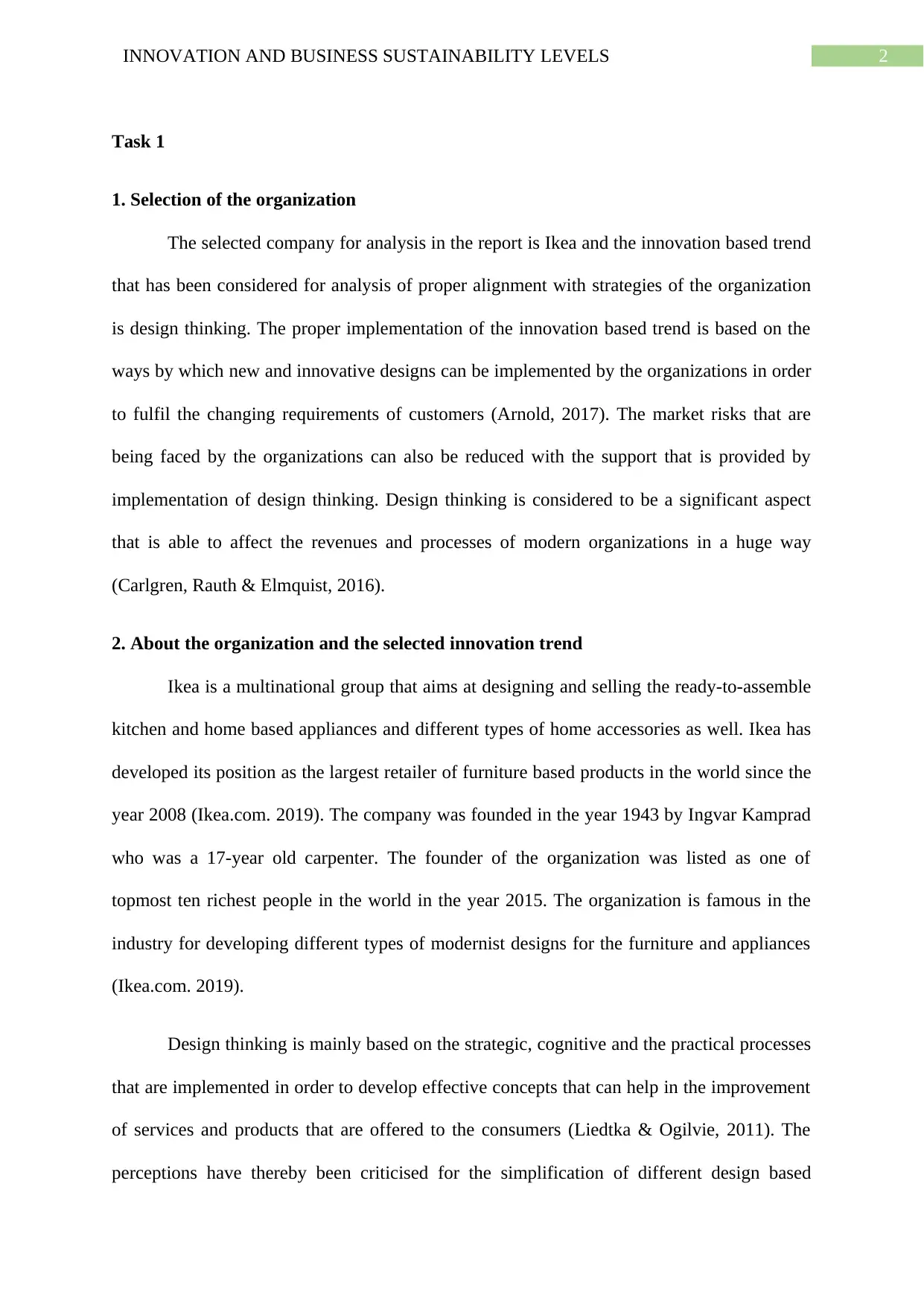
2INNOVATION AND BUSINESS SUSTAINABILITY LEVELS
Task 1
1. Selection of the organization
The selected company for analysis in the report is Ikea and the innovation based trend
that has been considered for analysis of proper alignment with strategies of the organization
is design thinking. The proper implementation of the innovation based trend is based on the
ways by which new and innovative designs can be implemented by the organizations in order
to fulfil the changing requirements of customers (Arnold, 2017). The market risks that are
being faced by the organizations can also be reduced with the support that is provided by
implementation of design thinking. Design thinking is considered to be a significant aspect
that is able to affect the revenues and processes of modern organizations in a huge way
(Carlgren, Rauth & Elmquist, 2016).
2. About the organization and the selected innovation trend
Ikea is a multinational group that aims at designing and selling the ready-to-assemble
kitchen and home based appliances and different types of home accessories as well. Ikea has
developed its position as the largest retailer of furniture based products in the world since the
year 2008 (Ikea.com. 2019). The company was founded in the year 1943 by Ingvar Kamprad
who was a 17-year old carpenter. The founder of the organization was listed as one of
topmost ten richest people in the world in the year 2015. The organization is famous in the
industry for developing different types of modernist designs for the furniture and appliances
(Ikea.com. 2019).
Design thinking is mainly based on the strategic, cognitive and the practical processes
that are implemented in order to develop effective concepts that can help in the improvement
of services and products that are offered to the consumers (Liedtka & Ogilvie, 2011). The
perceptions have thereby been criticised for the simplification of different design based
Task 1
1. Selection of the organization
The selected company for analysis in the report is Ikea and the innovation based trend
that has been considered for analysis of proper alignment with strategies of the organization
is design thinking. The proper implementation of the innovation based trend is based on the
ways by which new and innovative designs can be implemented by the organizations in order
to fulfil the changing requirements of customers (Arnold, 2017). The market risks that are
being faced by the organizations can also be reduced with the support that is provided by
implementation of design thinking. Design thinking is considered to be a significant aspect
that is able to affect the revenues and processes of modern organizations in a huge way
(Carlgren, Rauth & Elmquist, 2016).
2. About the organization and the selected innovation trend
Ikea is a multinational group that aims at designing and selling the ready-to-assemble
kitchen and home based appliances and different types of home accessories as well. Ikea has
developed its position as the largest retailer of furniture based products in the world since the
year 2008 (Ikea.com. 2019). The company was founded in the year 1943 by Ingvar Kamprad
who was a 17-year old carpenter. The founder of the organization was listed as one of
topmost ten richest people in the world in the year 2015. The organization is famous in the
industry for developing different types of modernist designs for the furniture and appliances
(Ikea.com. 2019).
Design thinking is mainly based on the strategic, cognitive and the practical processes
that are implemented in order to develop effective concepts that can help in the improvement
of services and products that are offered to the consumers (Liedtka & Ogilvie, 2011). The
perceptions have thereby been criticised for the simplification of different design based
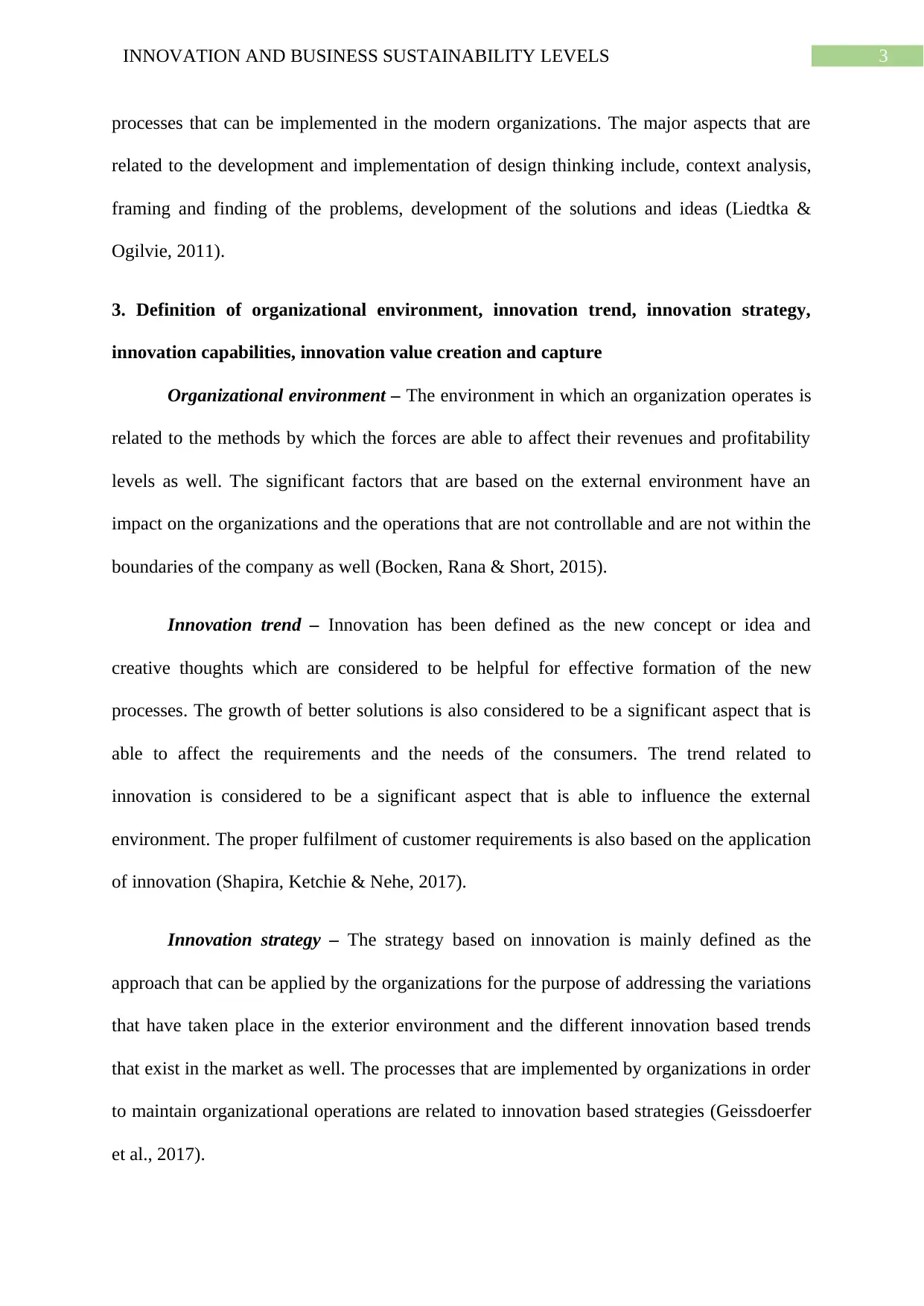
3INNOVATION AND BUSINESS SUSTAINABILITY LEVELS
processes that can be implemented in the modern organizations. The major aspects that are
related to the development and implementation of design thinking include, context analysis,
framing and finding of the problems, development of the solutions and ideas (Liedtka &
Ogilvie, 2011).
3. Definition of organizational environment, innovation trend, innovation strategy,
innovation capabilities, innovation value creation and capture
Organizational environment – The environment in which an organization operates is
related to the methods by which the forces are able to affect their revenues and profitability
levels as well. The significant factors that are based on the external environment have an
impact on the organizations and the operations that are not controllable and are not within the
boundaries of the company as well (Bocken, Rana & Short, 2015).
Innovation trend – Innovation has been defined as the new concept or idea and
creative thoughts which are considered to be helpful for effective formation of the new
processes. The growth of better solutions is also considered to be a significant aspect that is
able to affect the requirements and the needs of the consumers. The trend related to
innovation is considered to be a significant aspect that is able to influence the external
environment. The proper fulfilment of customer requirements is also based on the application
of innovation (Shapira, Ketchie & Nehe, 2017).
Innovation strategy – The strategy based on innovation is mainly defined as the
approach that can be applied by the organizations for the purpose of addressing the variations
that have taken place in the exterior environment and the different innovation based trends
that exist in the market as well. The processes that are implemented by organizations in order
to maintain organizational operations are related to innovation based strategies (Geissdoerfer
et al., 2017).
processes that can be implemented in the modern organizations. The major aspects that are
related to the development and implementation of design thinking include, context analysis,
framing and finding of the problems, development of the solutions and ideas (Liedtka &
Ogilvie, 2011).
3. Definition of organizational environment, innovation trend, innovation strategy,
innovation capabilities, innovation value creation and capture
Organizational environment – The environment in which an organization operates is
related to the methods by which the forces are able to affect their revenues and profitability
levels as well. The significant factors that are based on the external environment have an
impact on the organizations and the operations that are not controllable and are not within the
boundaries of the company as well (Bocken, Rana & Short, 2015).
Innovation trend – Innovation has been defined as the new concept or idea and
creative thoughts which are considered to be helpful for effective formation of the new
processes. The growth of better solutions is also considered to be a significant aspect that is
able to affect the requirements and the needs of the consumers. The trend related to
innovation is considered to be a significant aspect that is able to influence the external
environment. The proper fulfilment of customer requirements is also based on the application
of innovation (Shapira, Ketchie & Nehe, 2017).
Innovation strategy – The strategy based on innovation is mainly defined as the
approach that can be applied by the organizations for the purpose of addressing the variations
that have taken place in the exterior environment and the different innovation based trends
that exist in the market as well. The processes that are implemented by organizations in order
to maintain organizational operations are related to innovation based strategies (Geissdoerfer
et al., 2017).
Secure Best Marks with AI Grader
Need help grading? Try our AI Grader for instant feedback on your assignments.
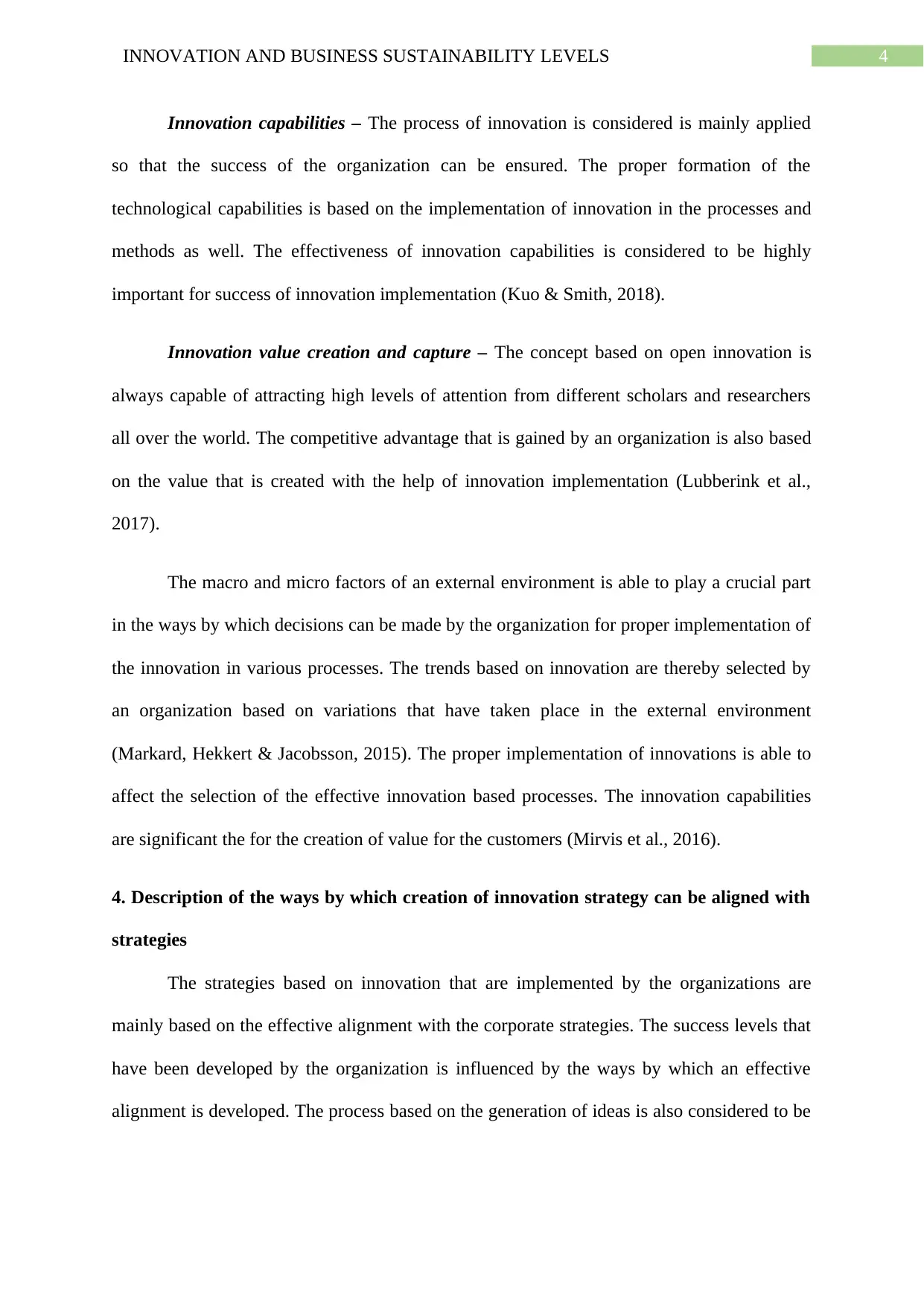
4INNOVATION AND BUSINESS SUSTAINABILITY LEVELS
Innovation capabilities – The process of innovation is considered is mainly applied
so that the success of the organization can be ensured. The proper formation of the
technological capabilities is based on the implementation of innovation in the processes and
methods as well. The effectiveness of innovation capabilities is considered to be highly
important for success of innovation implementation (Kuo & Smith, 2018).
Innovation value creation and capture – The concept based on open innovation is
always capable of attracting high levels of attention from different scholars and researchers
all over the world. The competitive advantage that is gained by an organization is also based
on the value that is created with the help of innovation implementation (Lubberink et al.,
2017).
The macro and micro factors of an external environment is able to play a crucial part
in the ways by which decisions can be made by the organization for proper implementation of
the innovation in various processes. The trends based on innovation are thereby selected by
an organization based on variations that have taken place in the external environment
(Markard, Hekkert & Jacobsson, 2015). The proper implementation of innovations is able to
affect the selection of the effective innovation based processes. The innovation capabilities
are significant the for the creation of value for the customers (Mirvis et al., 2016).
4. Description of the ways by which creation of innovation strategy can be aligned with
strategies
The strategies based on innovation that are implemented by the organizations are
mainly based on the effective alignment with the corporate strategies. The success levels that
have been developed by the organization is influenced by the ways by which an effective
alignment is developed. The process based on the generation of ideas is also considered to be
Innovation capabilities – The process of innovation is considered is mainly applied
so that the success of the organization can be ensured. The proper formation of the
technological capabilities is based on the implementation of innovation in the processes and
methods as well. The effectiveness of innovation capabilities is considered to be highly
important for success of innovation implementation (Kuo & Smith, 2018).
Innovation value creation and capture – The concept based on open innovation is
always capable of attracting high levels of attention from different scholars and researchers
all over the world. The competitive advantage that is gained by an organization is also based
on the value that is created with the help of innovation implementation (Lubberink et al.,
2017).
The macro and micro factors of an external environment is able to play a crucial part
in the ways by which decisions can be made by the organization for proper implementation of
the innovation in various processes. The trends based on innovation are thereby selected by
an organization based on variations that have taken place in the external environment
(Markard, Hekkert & Jacobsson, 2015). The proper implementation of innovations is able to
affect the selection of the effective innovation based processes. The innovation capabilities
are significant the for the creation of value for the customers (Mirvis et al., 2016).
4. Description of the ways by which creation of innovation strategy can be aligned with
strategies
The strategies based on innovation that are implemented by the organizations are
mainly based on the effective alignment with the corporate strategies. The success levels that
have been developed by the organization is influenced by the ways by which an effective
alignment is developed. The process based on the generation of ideas is also considered to be
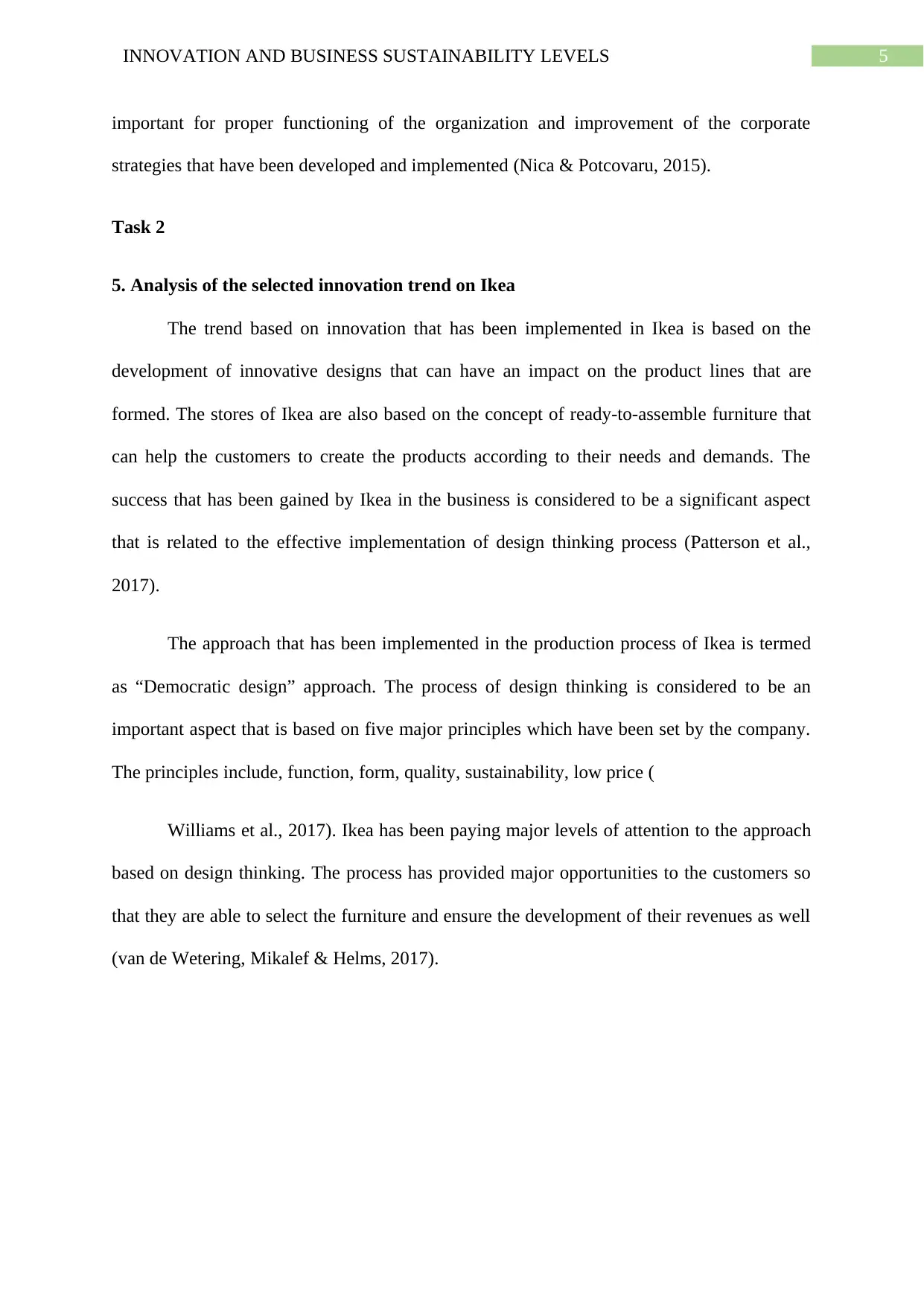
5INNOVATION AND BUSINESS SUSTAINABILITY LEVELS
important for proper functioning of the organization and improvement of the corporate
strategies that have been developed and implemented (Nica & Potcovaru, 2015).
Task 2
5. Analysis of the selected innovation trend on Ikea
The trend based on innovation that has been implemented in Ikea is based on the
development of innovative designs that can have an impact on the product lines that are
formed. The stores of Ikea are also based on the concept of ready-to-assemble furniture that
can help the customers to create the products according to their needs and demands. The
success that has been gained by Ikea in the business is considered to be a significant aspect
that is related to the effective implementation of design thinking process (Patterson et al.,
2017).
The approach that has been implemented in the production process of Ikea is termed
as “Democratic design” approach. The process of design thinking is considered to be an
important aspect that is based on five major principles which have been set by the company.
The principles include, function, form, quality, sustainability, low price (
Williams et al., 2017). Ikea has been paying major levels of attention to the approach
based on design thinking. The process has provided major opportunities to the customers so
that they are able to select the furniture and ensure the development of their revenues as well
(van de Wetering, Mikalef & Helms, 2017).
important for proper functioning of the organization and improvement of the corporate
strategies that have been developed and implemented (Nica & Potcovaru, 2015).
Task 2
5. Analysis of the selected innovation trend on Ikea
The trend based on innovation that has been implemented in Ikea is based on the
development of innovative designs that can have an impact on the product lines that are
formed. The stores of Ikea are also based on the concept of ready-to-assemble furniture that
can help the customers to create the products according to their needs and demands. The
success that has been gained by Ikea in the business is considered to be a significant aspect
that is related to the effective implementation of design thinking process (Patterson et al.,
2017).
The approach that has been implemented in the production process of Ikea is termed
as “Democratic design” approach. The process of design thinking is considered to be an
important aspect that is based on five major principles which have been set by the company.
The principles include, function, form, quality, sustainability, low price (
Williams et al., 2017). Ikea has been paying major levels of attention to the approach
based on design thinking. The process has provided major opportunities to the customers so
that they are able to select the furniture and ensure the development of their revenues as well
(van de Wetering, Mikalef & Helms, 2017).
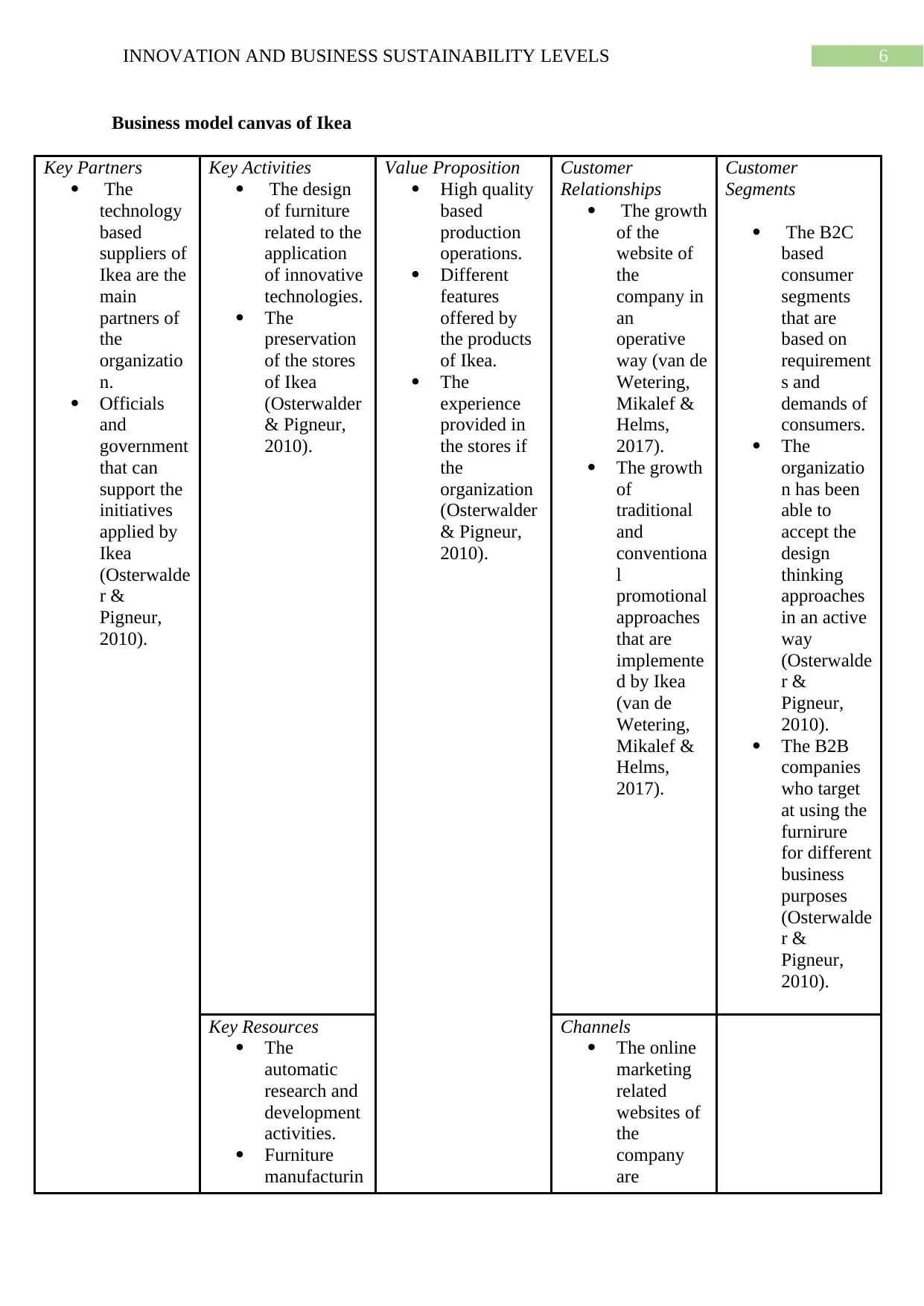
6INNOVATION AND BUSINESS SUSTAINABILITY LEVELS
Business model canvas of Ikea
Key Partners
The
technology
based
suppliers of
Ikea are the
main
partners of
the
organizatio
n.
Officials
and
government
that can
support the
initiatives
applied by
Ikea
(Osterwalde
r &
Pigneur,
2010).
Key Activities
The design
of furniture
related to the
application
of innovative
technologies.
The
preservation
of the stores
of Ikea
(Osterwalder
& Pigneur,
2010).
Value Proposition
High quality
based
production
operations.
Different
features
offered by
the products
of Ikea.
The
experience
provided in
the stores if
the
organization
(Osterwalder
& Pigneur,
2010).
Customer
Relationships
The growth
of the
website of
the
company in
an
operative
way (van de
Wetering,
Mikalef &
Helms,
2017).
The growth
of
traditional
and
conventiona
l
promotional
approaches
that are
implemente
d by Ikea
(van de
Wetering,
Mikalef &
Helms,
2017).
Customer
Segments
The B2C
based
consumer
segments
that are
based on
requirement
s and
demands of
consumers.
The
organizatio
n has been
able to
accept the
design
thinking
approaches
in an active
way
(Osterwalde
r &
Pigneur,
2010).
The B2B
companies
who target
at using the
furnirure
for different
business
purposes
(Osterwalde
r &
Pigneur,
2010).
Key Resources
The
automatic
research and
development
activities.
Furniture
manufacturin
Channels
The online
marketing
related
websites of
the
company
are
Business model canvas of Ikea
Key Partners
The
technology
based
suppliers of
Ikea are the
main
partners of
the
organizatio
n.
Officials
and
government
that can
support the
initiatives
applied by
Ikea
(Osterwalde
r &
Pigneur,
2010).
Key Activities
The design
of furniture
related to the
application
of innovative
technologies.
The
preservation
of the stores
of Ikea
(Osterwalder
& Pigneur,
2010).
Value Proposition
High quality
based
production
operations.
Different
features
offered by
the products
of Ikea.
The
experience
provided in
the stores if
the
organization
(Osterwalder
& Pigneur,
2010).
Customer
Relationships
The growth
of the
website of
the
company in
an
operative
way (van de
Wetering,
Mikalef &
Helms,
2017).
The growth
of
traditional
and
conventiona
l
promotional
approaches
that are
implemente
d by Ikea
(van de
Wetering,
Mikalef &
Helms,
2017).
Customer
Segments
The B2C
based
consumer
segments
that are
based on
requirement
s and
demands of
consumers.
The
organizatio
n has been
able to
accept the
design
thinking
approaches
in an active
way
(Osterwalde
r &
Pigneur,
2010).
The B2B
companies
who target
at using the
furnirure
for different
business
purposes
(Osterwalde
r &
Pigneur,
2010).
Key Resources
The
automatic
research and
development
activities.
Furniture
manufacturin
Channels
The online
marketing
related
websites of
the
company
are
Paraphrase This Document
Need a fresh take? Get an instant paraphrase of this document with our AI Paraphraser
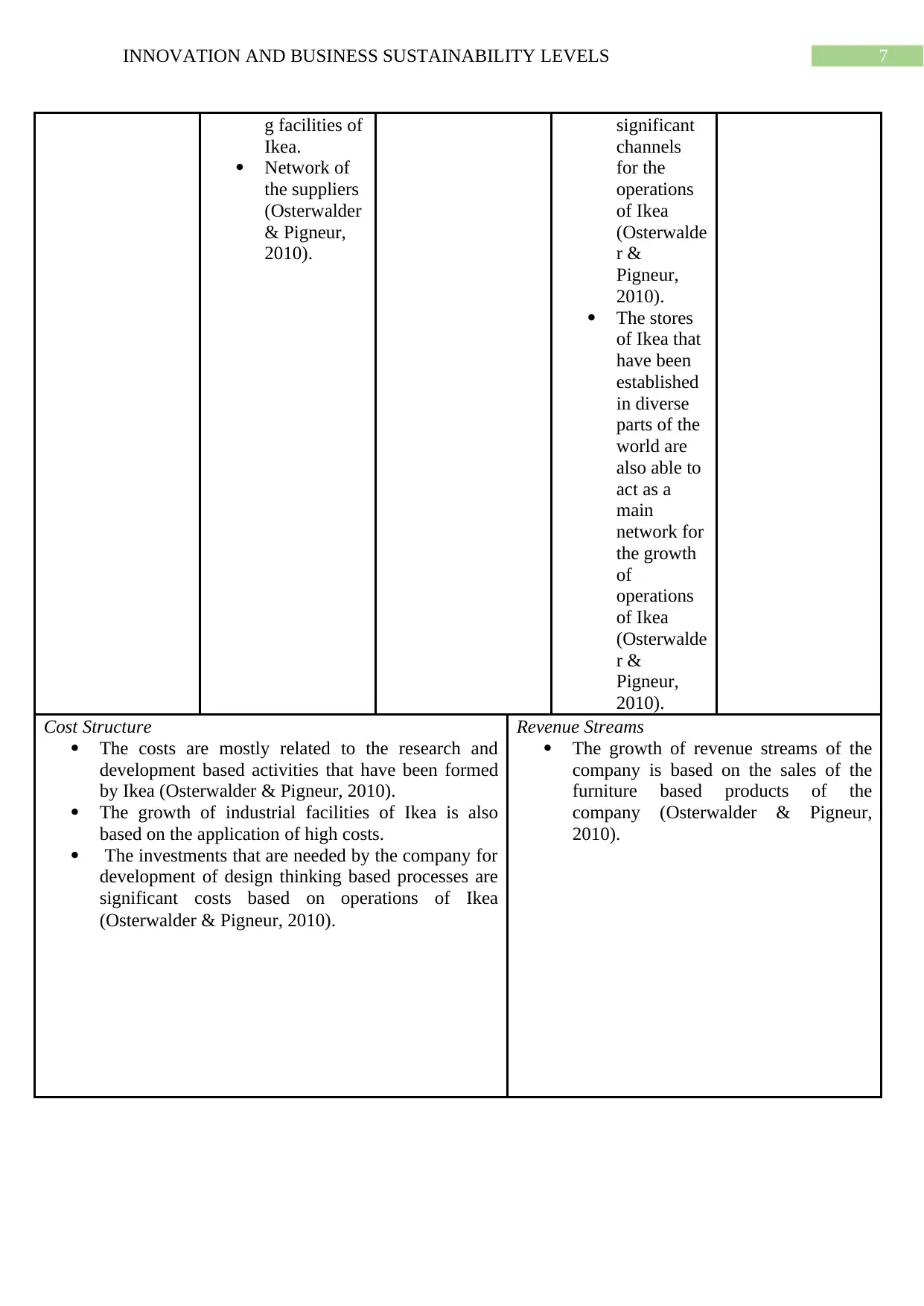
7INNOVATION AND BUSINESS SUSTAINABILITY LEVELS
g facilities of
Ikea.
Network of
the suppliers
(Osterwalder
& Pigneur,
2010).
significant
channels
for the
operations
of Ikea
(Osterwalde
r &
Pigneur,
2010).
The stores
of Ikea that
have been
established
in diverse
parts of the
world are
also able to
act as a
main
network for
the growth
of
operations
of Ikea
(Osterwalde
r &
Pigneur,
2010).
Cost Structure
The costs are mostly related to the research and
development based activities that have been formed
by Ikea (Osterwalder & Pigneur, 2010).
The growth of industrial facilities of Ikea is also
based on the application of high costs.
The investments that are needed by the company for
development of design thinking based processes are
significant costs based on operations of Ikea
(Osterwalder & Pigneur, 2010).
Revenue Streams
The growth of revenue streams of the
company is based on the sales of the
furniture based products of the
company (Osterwalder & Pigneur,
2010).
g facilities of
Ikea.
Network of
the suppliers
(Osterwalder
& Pigneur,
2010).
significant
channels
for the
operations
of Ikea
(Osterwalde
r &
Pigneur,
2010).
The stores
of Ikea that
have been
established
in diverse
parts of the
world are
also able to
act as a
main
network for
the growth
of
operations
of Ikea
(Osterwalde
r &
Pigneur,
2010).
Cost Structure
The costs are mostly related to the research and
development based activities that have been formed
by Ikea (Osterwalder & Pigneur, 2010).
The growth of industrial facilities of Ikea is also
based on the application of high costs.
The investments that are needed by the company for
development of design thinking based processes are
significant costs based on operations of Ikea
(Osterwalder & Pigneur, 2010).
Revenue Streams
The growth of revenue streams of the
company is based on the sales of the
furniture based products of the
company (Osterwalder & Pigneur,
2010).
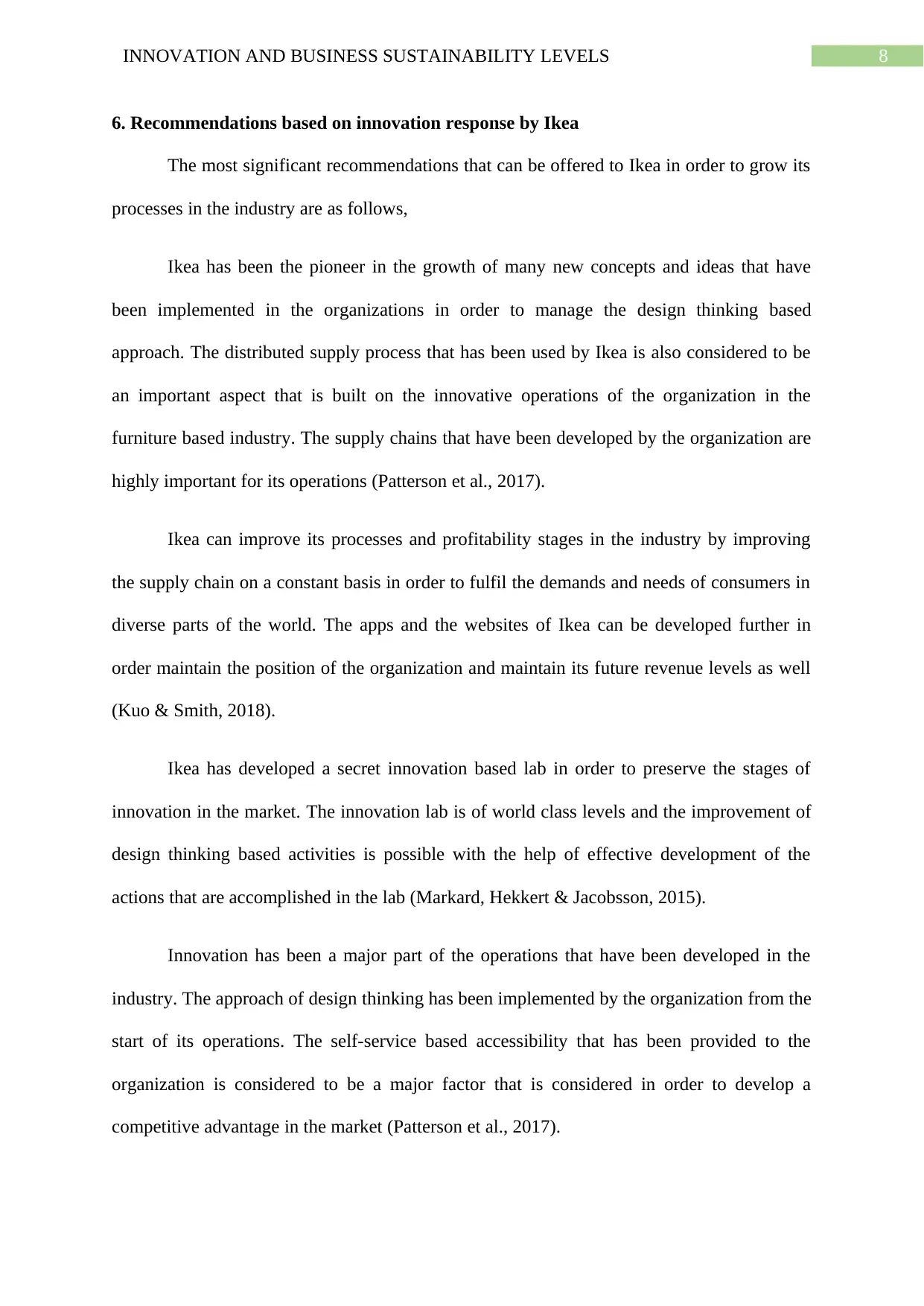
8INNOVATION AND BUSINESS SUSTAINABILITY LEVELS
6. Recommendations based on innovation response by Ikea
The most significant recommendations that can be offered to Ikea in order to grow its
processes in the industry are as follows,
Ikea has been the pioneer in the growth of many new concepts and ideas that have
been implemented in the organizations in order to manage the design thinking based
approach. The distributed supply process that has been used by Ikea is also considered to be
an important aspect that is built on the innovative operations of the organization in the
furniture based industry. The supply chains that have been developed by the organization are
highly important for its operations (Patterson et al., 2017).
Ikea can improve its processes and profitability stages in the industry by improving
the supply chain on a constant basis in order to fulfil the demands and needs of consumers in
diverse parts of the world. The apps and the websites of Ikea can be developed further in
order maintain the position of the organization and maintain its future revenue levels as well
(Kuo & Smith, 2018).
Ikea has developed a secret innovation based lab in order to preserve the stages of
innovation in the market. The innovation lab is of world class levels and the improvement of
design thinking based activities is possible with the help of effective development of the
actions that are accomplished in the lab (Markard, Hekkert & Jacobsson, 2015).
Innovation has been a major part of the operations that have been developed in the
industry. The approach of design thinking has been implemented by the organization from the
start of its operations. The self-service based accessibility that has been provided to the
organization is considered to be a major factor that is considered in order to develop a
competitive advantage in the market (Patterson et al., 2017).
6. Recommendations based on innovation response by Ikea
The most significant recommendations that can be offered to Ikea in order to grow its
processes in the industry are as follows,
Ikea has been the pioneer in the growth of many new concepts and ideas that have
been implemented in the organizations in order to manage the design thinking based
approach. The distributed supply process that has been used by Ikea is also considered to be
an important aspect that is built on the innovative operations of the organization in the
furniture based industry. The supply chains that have been developed by the organization are
highly important for its operations (Patterson et al., 2017).
Ikea can improve its processes and profitability stages in the industry by improving
the supply chain on a constant basis in order to fulfil the demands and needs of consumers in
diverse parts of the world. The apps and the websites of Ikea can be developed further in
order maintain the position of the organization and maintain its future revenue levels as well
(Kuo & Smith, 2018).
Ikea has developed a secret innovation based lab in order to preserve the stages of
innovation in the market. The innovation lab is of world class levels and the improvement of
design thinking based activities is possible with the help of effective development of the
actions that are accomplished in the lab (Markard, Hekkert & Jacobsson, 2015).
Innovation has been a major part of the operations that have been developed in the
industry. The approach of design thinking has been implemented by the organization from the
start of its operations. The self-service based accessibility that has been provided to the
organization is considered to be a major factor that is considered in order to develop a
competitive advantage in the market (Patterson et al., 2017).
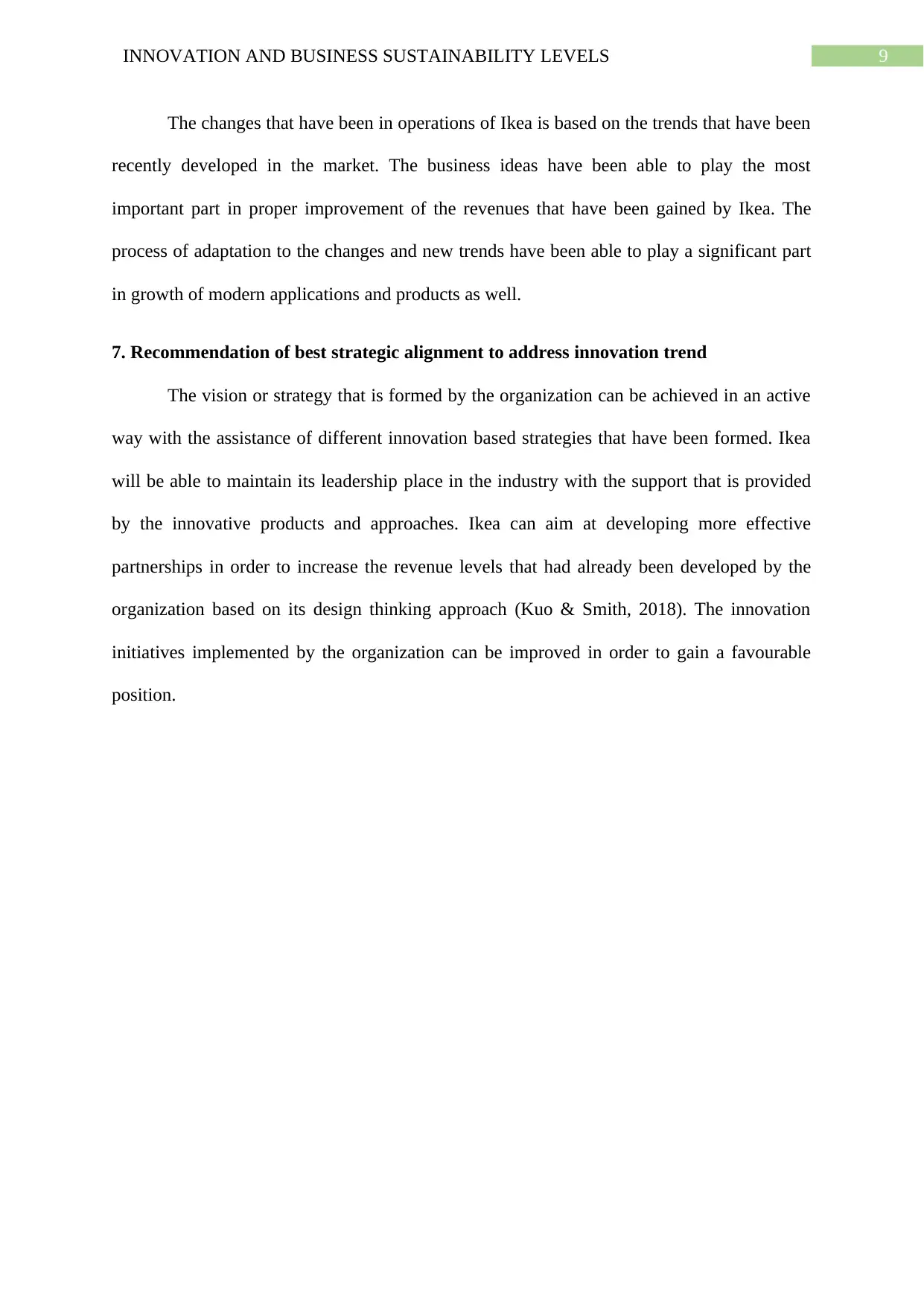
9INNOVATION AND BUSINESS SUSTAINABILITY LEVELS
The changes that have been in operations of Ikea is based on the trends that have been
recently developed in the market. The business ideas have been able to play the most
important part in proper improvement of the revenues that have been gained by Ikea. The
process of adaptation to the changes and new trends have been able to play a significant part
in growth of modern applications and products as well.
7. Recommendation of best strategic alignment to address innovation trend
The vision or strategy that is formed by the organization can be achieved in an active
way with the assistance of different innovation based strategies that have been formed. Ikea
will be able to maintain its leadership place in the industry with the support that is provided
by the innovative products and approaches. Ikea can aim at developing more effective
partnerships in order to increase the revenue levels that had already been developed by the
organization based on its design thinking approach (Kuo & Smith, 2018). The innovation
initiatives implemented by the organization can be improved in order to gain a favourable
position.
The changes that have been in operations of Ikea is based on the trends that have been
recently developed in the market. The business ideas have been able to play the most
important part in proper improvement of the revenues that have been gained by Ikea. The
process of adaptation to the changes and new trends have been able to play a significant part
in growth of modern applications and products as well.
7. Recommendation of best strategic alignment to address innovation trend
The vision or strategy that is formed by the organization can be achieved in an active
way with the assistance of different innovation based strategies that have been formed. Ikea
will be able to maintain its leadership place in the industry with the support that is provided
by the innovative products and approaches. Ikea can aim at developing more effective
partnerships in order to increase the revenue levels that had already been developed by the
organization based on its design thinking approach (Kuo & Smith, 2018). The innovation
initiatives implemented by the organization can be improved in order to gain a favourable
position.
Secure Best Marks with AI Grader
Need help grading? Try our AI Grader for instant feedback on your assignments.
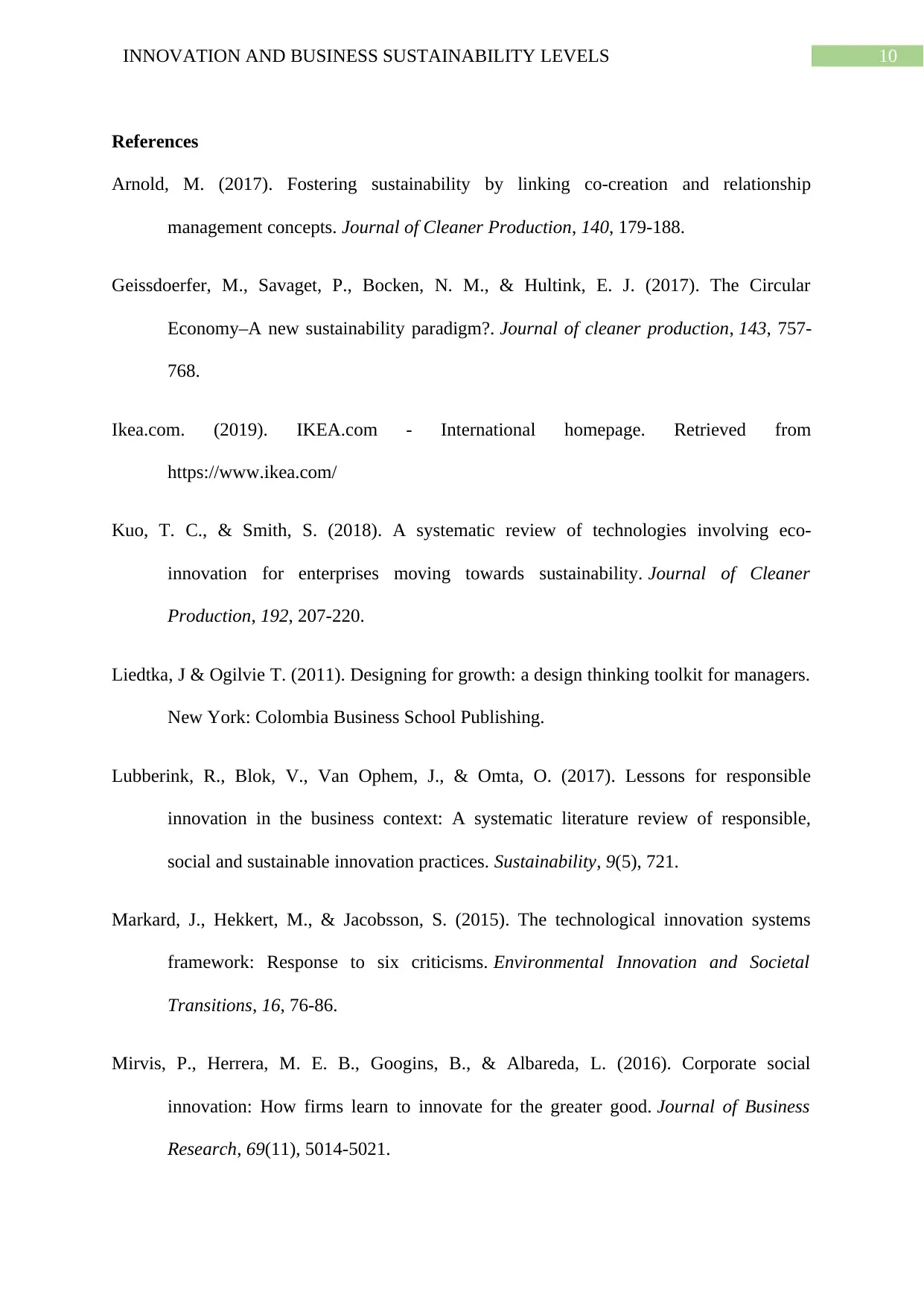
10INNOVATION AND BUSINESS SUSTAINABILITY LEVELS
References
Arnold, M. (2017). Fostering sustainability by linking co-creation and relationship
management concepts. Journal of Cleaner Production, 140, 179-188.
Geissdoerfer, M., Savaget, P., Bocken, N. M., & Hultink, E. J. (2017). The Circular
Economy–A new sustainability paradigm?. Journal of cleaner production, 143, 757-
768.
Ikea.com. (2019). IKEA.com - International homepage. Retrieved from
https://www.ikea.com/
Kuo, T. C., & Smith, S. (2018). A systematic review of technologies involving eco-
innovation for enterprises moving towards sustainability. Journal of Cleaner
Production, 192, 207-220.
Liedtka, J & Ogilvie T. (2011). Designing for growth: a design thinking toolkit for managers.
New York: Colombia Business School Publishing.
Lubberink, R., Blok, V., Van Ophem, J., & Omta, O. (2017). Lessons for responsible
innovation in the business context: A systematic literature review of responsible,
social and sustainable innovation practices. Sustainability, 9(5), 721.
Markard, J., Hekkert, M., & Jacobsson, S. (2015). The technological innovation systems
framework: Response to six criticisms. Environmental Innovation and Societal
Transitions, 16, 76-86.
Mirvis, P., Herrera, M. E. B., Googins, B., & Albareda, L. (2016). Corporate social
innovation: How firms learn to innovate for the greater good. Journal of Business
Research, 69(11), 5014-5021.
References
Arnold, M. (2017). Fostering sustainability by linking co-creation and relationship
management concepts. Journal of Cleaner Production, 140, 179-188.
Geissdoerfer, M., Savaget, P., Bocken, N. M., & Hultink, E. J. (2017). The Circular
Economy–A new sustainability paradigm?. Journal of cleaner production, 143, 757-
768.
Ikea.com. (2019). IKEA.com - International homepage. Retrieved from
https://www.ikea.com/
Kuo, T. C., & Smith, S. (2018). A systematic review of technologies involving eco-
innovation for enterprises moving towards sustainability. Journal of Cleaner
Production, 192, 207-220.
Liedtka, J & Ogilvie T. (2011). Designing for growth: a design thinking toolkit for managers.
New York: Colombia Business School Publishing.
Lubberink, R., Blok, V., Van Ophem, J., & Omta, O. (2017). Lessons for responsible
innovation in the business context: A systematic literature review of responsible,
social and sustainable innovation practices. Sustainability, 9(5), 721.
Markard, J., Hekkert, M., & Jacobsson, S. (2015). The technological innovation systems
framework: Response to six criticisms. Environmental Innovation and Societal
Transitions, 16, 76-86.
Mirvis, P., Herrera, M. E. B., Googins, B., & Albareda, L. (2016). Corporate social
innovation: How firms learn to innovate for the greater good. Journal of Business
Research, 69(11), 5014-5021.
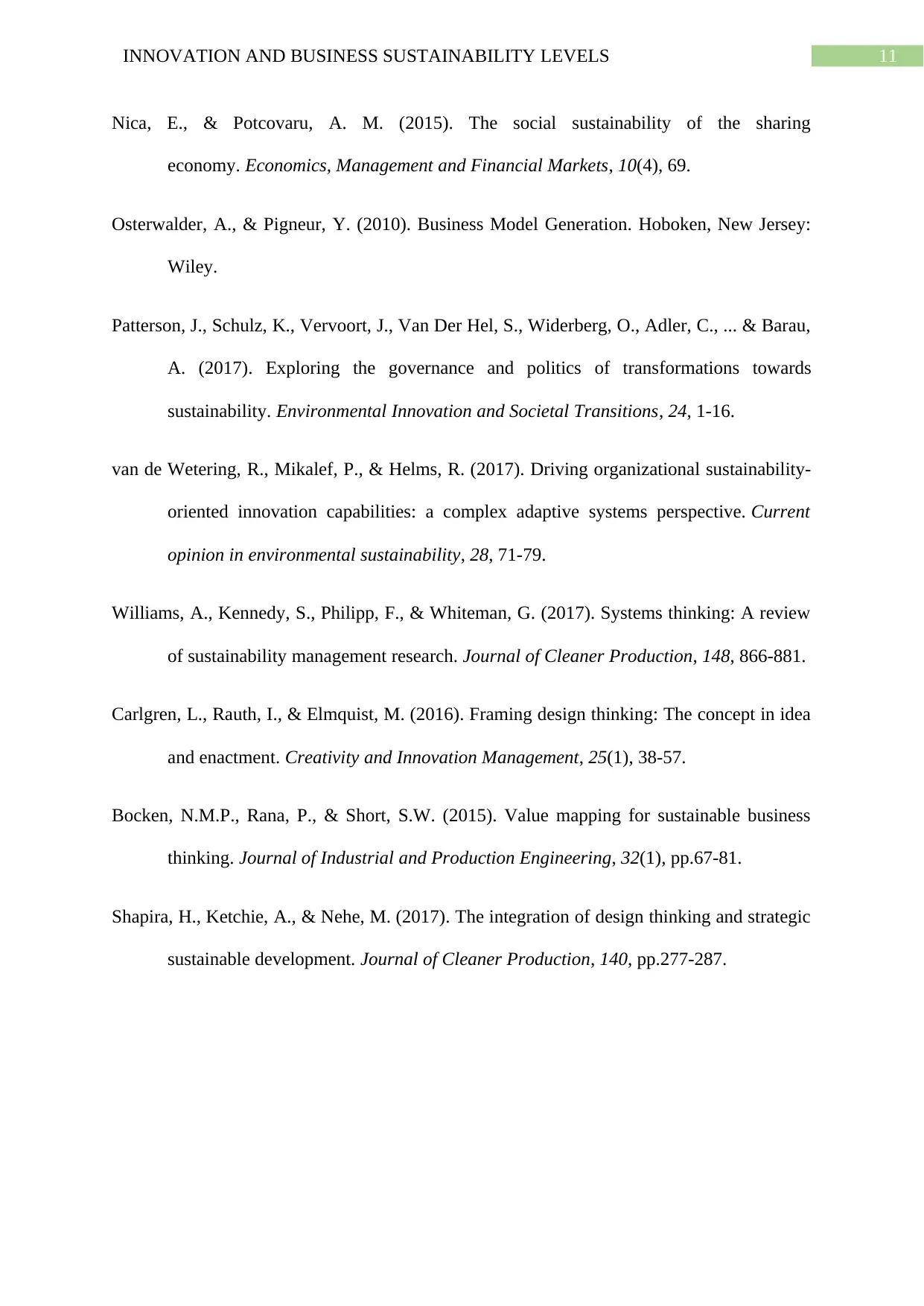
11INNOVATION AND BUSINESS SUSTAINABILITY LEVELS
Nica, E., & Potcovaru, A. M. (2015). The social sustainability of the sharing
economy. Economics, Management and Financial Markets, 10(4), 69.
Osterwalder, A., & Pigneur, Y. (2010). Business Model Generation. Hoboken, New Jersey:
Wiley.
Patterson, J., Schulz, K., Vervoort, J., Van Der Hel, S., Widerberg, O., Adler, C., ... & Barau,
A. (2017). Exploring the governance and politics of transformations towards
sustainability. Environmental Innovation and Societal Transitions, 24, 1-16.
van de Wetering, R., Mikalef, P., & Helms, R. (2017). Driving organizational sustainability-
oriented innovation capabilities: a complex adaptive systems perspective. Current
opinion in environmental sustainability, 28, 71-79.
Williams, A., Kennedy, S., Philipp, F., & Whiteman, G. (2017). Systems thinking: A review
of sustainability management research. Journal of Cleaner Production, 148, 866-881.
Carlgren, L., Rauth, I., & Elmquist, M. (2016). Framing design thinking: The concept in idea
and enactment. Creativity and Innovation Management, 25(1), 38-57.
Bocken, N.M.P., Rana, P., & Short, S.W. (2015). Value mapping for sustainable business
thinking. Journal of Industrial and Production Engineering, 32(1), pp.67-81.
Shapira, H., Ketchie, A., & Nehe, M. (2017). The integration of design thinking and strategic
sustainable development. Journal of Cleaner Production, 140, pp.277-287.
Nica, E., & Potcovaru, A. M. (2015). The social sustainability of the sharing
economy. Economics, Management and Financial Markets, 10(4), 69.
Osterwalder, A., & Pigneur, Y. (2010). Business Model Generation. Hoboken, New Jersey:
Wiley.
Patterson, J., Schulz, K., Vervoort, J., Van Der Hel, S., Widerberg, O., Adler, C., ... & Barau,
A. (2017). Exploring the governance and politics of transformations towards
sustainability. Environmental Innovation and Societal Transitions, 24, 1-16.
van de Wetering, R., Mikalef, P., & Helms, R. (2017). Driving organizational sustainability-
oriented innovation capabilities: a complex adaptive systems perspective. Current
opinion in environmental sustainability, 28, 71-79.
Williams, A., Kennedy, S., Philipp, F., & Whiteman, G. (2017). Systems thinking: A review
of sustainability management research. Journal of Cleaner Production, 148, 866-881.
Carlgren, L., Rauth, I., & Elmquist, M. (2016). Framing design thinking: The concept in idea
and enactment. Creativity and Innovation Management, 25(1), 38-57.
Bocken, N.M.P., Rana, P., & Short, S.W. (2015). Value mapping for sustainable business
thinking. Journal of Industrial and Production Engineering, 32(1), pp.67-81.
Shapira, H., Ketchie, A., & Nehe, M. (2017). The integration of design thinking and strategic
sustainable development. Journal of Cleaner Production, 140, pp.277-287.
1 out of 12
Related Documents
Your All-in-One AI-Powered Toolkit for Academic Success.
+13062052269
info@desklib.com
Available 24*7 on WhatsApp / Email
![[object Object]](/_next/static/media/star-bottom.7253800d.svg)
Unlock your academic potential
© 2024 | Zucol Services PVT LTD | All rights reserved.





